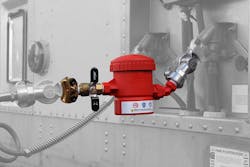Bob Allen grew up extremely comfortable around cars and trucks — his youth spent covered in grease rebuilding motors and early adulthood hauling freight out of Chicago’s McCormick Place. However, heading out during those brutal Midwest blizzards of the 1980s, leaving behind a worried wife in the Windy City, Allen was anything but comfortable.
“It was treacherous out there,” Allen recalled. “There were nights I was out there at two or three in the morning praying to God I make it to my next stop.”
Lake Michigan winters have a way of making any time of day treacherous, as Allen found out. Enough so that his time on the wintery roads inspired him to create an intermediary reservoir that hooks up to a tractor and trailer to inject the fluid into the brake system to prevent the brakes from freezing or locking. It’s called the Brake Releaser, and manufacturer Milton Industries made the tool available for sale in late November.
Not many have had the same motivation as Allen, which came one morning while he was heading back home, northbound on Interstate 65 from Indianapolis. A whiteout blanketed the sky and shrouded Allen’s GMC General truck’s mirror. What he could make out in the flaky haze was a jackknifing trailer coming his way.
The then 28-year-old thought he was going to get hit by this out-of-control truck and accelerated to avoid collision.
“When I sped up, the trailer straightened out and I figured out it was me jackknifing,” Allen said.
Next, the still-askew trailer was barreling towards a state trooper on the side of the road directing traffic from the closed-down highway. That officer now was the one taking evasive action, jumping into the adjacent field to avoid getting hit by the trailer.
“I just missed him,” Allen recounted. While the trucker was freeing the frozen trailer brakes with a blowtorch and hammer to get it to the side of the road, that same trooper stationed himself farther up the road to warn people of the downed truck.
This was about 30 years ago, though the moment is still frozen in time to Allen. He thought often of the near-disaster and ways it could have been avoided.
Jackknifing — when the trailer swings out from the tractor — is basically the cart trying to put itself before the horse. Icy or slick roads, and improper or failing brakes (because the trailer tires are moving faster than the braking tractor’s) are usually the culprit. The brake failure occurs when moisture enters the brake lines and freezes, preventing the air that activates the brakes from reaching its destination.
This can happen when a truck is coming from a southern terminal or warehouse to a cold region, causing condensation in the line to crystalize. Allen said his truck’s ill-performing air dryer most likely led to the excess condensation in his trailer’s line, causing his jackknife.
But how do you keep trailer brakes and valves from freezing up?
A common way is to vent the brake line by tugging on a trailer cord, which is typically part of pre- and post-trip checklists, though not always followed. Sometimes a more direct approach is required, Allen explained, and you must take a gallon jug of de-icing fluid and try to channel it into the stretched out curly-q’d emergency line’s narrow opening, hoping you pour more in the hose than on your sleeve.
And if that doesn’t work and the brakes do freeze up, you need to crawl under the trailer frame with a blowtorch to heat the valves and melt the ice crystals. You do whatever you must to create a clear path for air to activate the brakes. Moisture may also get into the brake drum and freeze; tapping on the brake shoes should release them from the drum. Hitting these in the wrong spot can create severe (and costly) damage as well.
De-icing inspiration
For all these reasons, and the haunting memory of nearly killing a state trooper, Allen clung to that lingering feeling that there had to be a better way. He thought of it often: on lonely stretches of highway, and later when he became a driver for the city of Chicago. Using his own experience and the tribal knowledge of the many truckers he had met over the years, he began to design a solution.
In 2013, he produced his first prototype de-icing fluid delivery system. A mold was created and Allen distributed 50 to other truckers. The tool finally came to mass market in late November in the form of the Milton Industries Brake Releaser. The attachment promises to clear frozen lines in minutes or prevent freeze-up from ever happening.
The simple red tool, about the size of an oil filter, quickly couples to the trailer emergency line glad hand and tractor service hose. The operator unscrews the cap, pours up to 8 oz. in and screws the cap back on.
After opening the valve attached to the device, push in the red trailer air supply line button. When the intermittent honking noises— which sound like Donald Duck cursing up a storm — subside, that means all the liquid has been forced into the system.
The Brake Releaser also has a pressure relief valve to vent built-up air in the container.
This is recommended as a preventative method before shoving off after a drop-and-hook and when finishing up for the day as a post-trip routine.
The newer Milton-made version is backed by industrial testing and minor improvement, such as preventing drippage from the reservoir. It's compatible with semi-trailers, flatbeds or any other trailer with an air brake system, and has a max pressure of 150 PSI and max low temperature of -40° F.
Bob Holley, a City of Chicago water maintenance driver, said he has used the original version of the Brake Releaser for four years “because I got tired of sitting, waiting for the city's fleet services to come out if I had a problem.”
The veteran trucker with 40 years of experience explained what is happening in that line to cause this particular problem: “What makes the brakes freeze is you get just a little bit of condensation in the valve and it'll stick and it won't let the air open it up. And this Brake Releaser really does the trick. It really opens that valve up.”
Holley uses the system before the weather turns cold as a pre-treater and to clear out particulates and sludge the air blows back form the engine dry heater.
“It's not only for releasing the brakes, it's great to use as a preventative measure to alleviate any problems," he said.
Allen said adding an extra shot of de-icer will allow some fluid to sit in the primary tank, so with every stomp of the brake pedal, air will rush in and spritz the system with the clearing agent.
Fleet response
About five years ago, Allen took his first prototype, which he patented with help from an architect friend, to a conference to demonstrate how it worked. Rocky Caylor, a former UPS certified driver trainer and now president and CEO of Cadence Premier Logistics, was there and was immediately impressed.
“We always had freeze up problems,” Caylor recalled, noting that his drivers were shown the inefficient method of messily pouring liquid into the air line. “Then you have drivers dragging the trailers creating flat spots or ruining the brakes trying to free them up.”
He pulled the would-be inventor Allen aside.
“Bob, we need to talk about this,” Caylor said. “You need to bring it out so we can try out this thing. Why no one's ever thought of this before, I have no idea!”
The mechanics at Cadence, a safety-award winning fleet with 300 trucks and about 1,000 trailers operating out of Joliet, Ill., started using the system soon after.
“We completely eliminated frozen brakes,” Caylor said.
He also said the $349 tool will “easily” yield an ROI in the first winter of use.
A repair service is going to charge $250 for showing up and then labor after, Caylor said, and that doesn’t factor in what downtime costs the fleet.
“There’s the possibility of missing a pickup or missing a delivery because of frozen brakes and you're waiting on that service,” he said, adding a scale house could administer an out-of-service violation for flat-spotted tires.
Allen claimed his sister’s trucking company, which often hauls for McDonalds, had spent $16,000 in five years due to frozen brakes, though it hasn’t had any freeze-ups since using her brother’s device.
After Caylor and Allen’s encounter, a tollway maintenance worker thawing a tractor-trailer’s frozen brakes on the side of I-88 in Illinois was killed when another semi barreled into and igniting the scene. A state trooper was critically injured and put in a six-week medically induced coma.
"At some point, I woke up in my squad car, burning alive," the trooper, Douglas Balder said at the trial of the fatigued truck driver who allegedly falsified log books.
Caylor, who is on the executive board of the Illinois Trucking Association, said after seeing the Brake Releaser, the Illinois Tollway supplied its maintenance vendors to carry the device with them on winter serive calls.
It’s quite a journey from nearly knocking a state trooper out of his boots to making sure others can make it home without incident.
Allen said that getting people home safe was his driving influence the whole way through. And he did it not with an engineering degree, but by a lifetime on the road listening to and observing other drivers. He also saw what not to do, such as warming up Coca-Cola on the dash and pouring it into the line as a sticky substitute for de-icer.
“People that drive the road are a different breed of people, you learn a lot of stuff from those guys,” Allen said matter-of-factly.
“It's either learn it or you stay stuck where you're at.”
And with Allen’s gadget, there’s hope that from this winter on, fewer truckers will be stuck where they're at.
About the Author
John Hitch
Editor
John Hitch is the editor-in-chief of Fleet Maintenance, providing maintenance management and technicians with the the latest information on the tools and strategies to keep their fleets' commercial vehicles moving. He is based out of Cleveland, Ohio, and was previously senior editor for FleetOwner. He previously wrote about manufacturing and advanced technology for IndustryWeek and New Equipment Digest.


